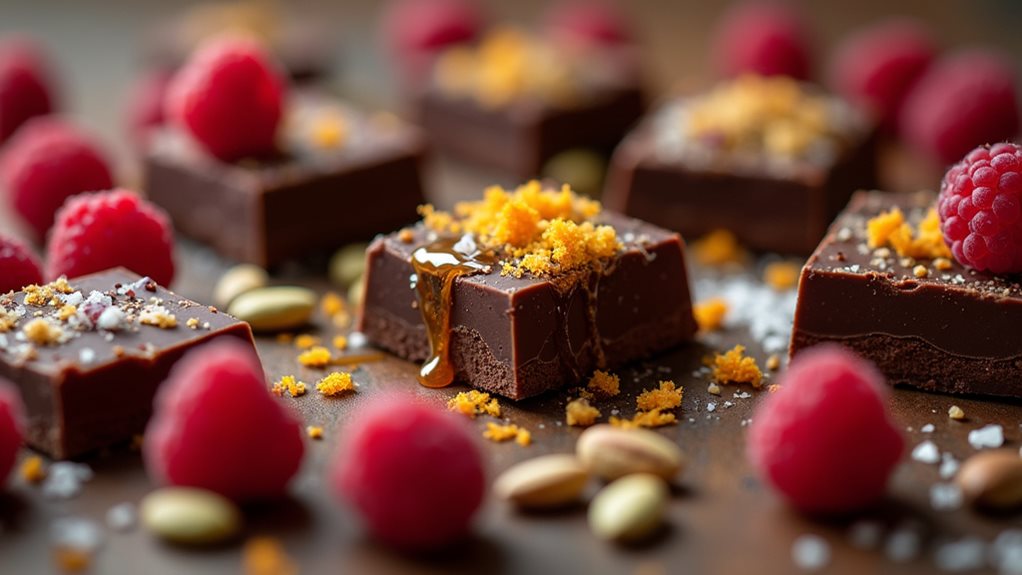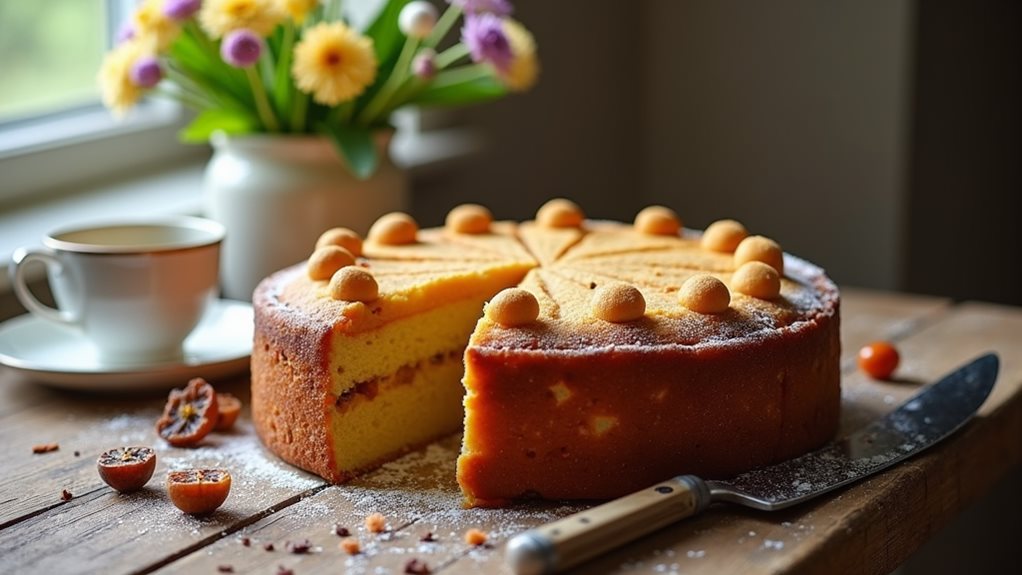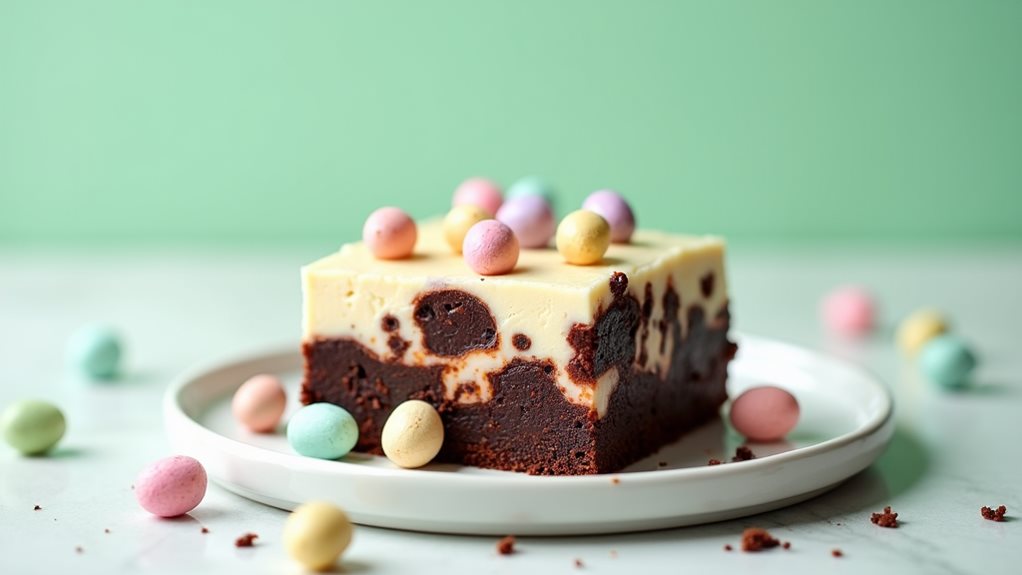Chocolate pairs beautifully with complementary flavors that enhance its natural richness. Dark chocolate works well with tart fruits like raspberries, bold spices, and oak-aged spirits. Milk chocolate shines alongside almonds, strawberries, and creamy cheeses. White chocolate benefits from bright citrus, herbal notes, and buttery nuts like macadamias. Consider textural contrasts too—smooth chocolate against crunchy toasted nuts creates sensory excitement. The interplay between sweet, salty, sour, bitter, and umami opens endless pairing possibilities to explore.
The Science of Chocolate's Perfect Partners
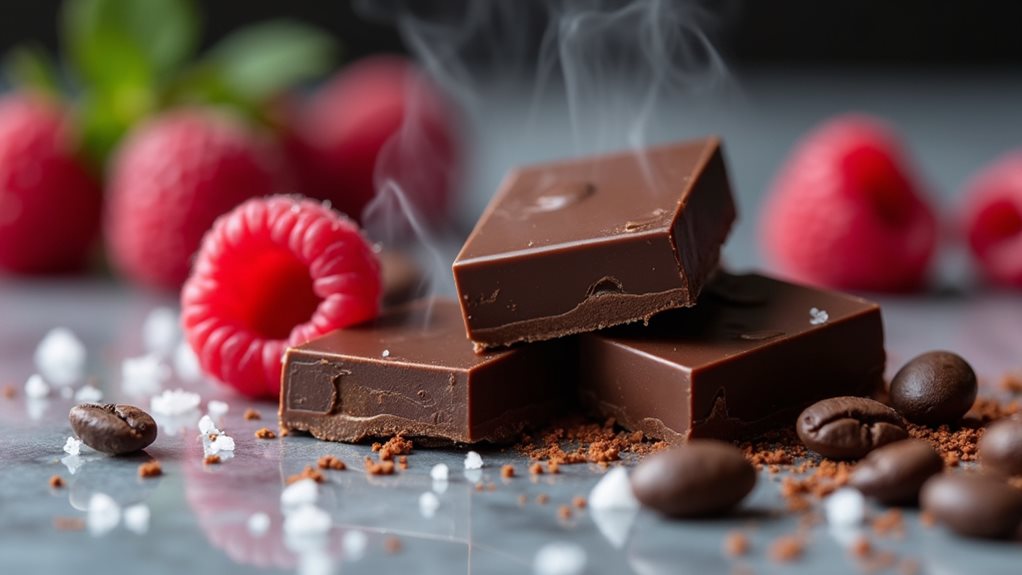
Every successful chocolate pairing relies on a complex interplay of flavors, aromas, and textures that create memorable taste experiences.
When you explore chocolate chemistry, you'll discover how molecular structures in chocolate complement certain foods—like almonds, whose fatty content harmonizes perfectly with cacao's composition.
Understanding chocolate's flavor profiles reveals endless pairing possibilities. The five taste categories (sweet, salty, sour, bitter, and umami) serve as your roadmap for experimentation. The intricate flavors of chocolate can range from bitter to sweet, creating a diverse foundation for pairings.
Notice how salt can actually enhance sweetness, or how similar aromatic compounds make chocolate and coffee natural companions.
You'll find texture equally important; the contrast between smooth chocolate and crunchy nuts creates depth that excites your palate.
Don't hesitate to explore unconventional pairings—sometimes the most surprising combinations deliver the most remarkable results.
Beverage selection plays a crucial role in chocolate tasting, with options like Riesling wine providing excellent complementary notes to milk chocolate varieties.
Dark Chocolate: Bold and Complex Companions
When exploring the world of dark chocolate pairings, you'll discover a rich tapestry of flavors that can transform your tasting experience. The key lies in finding flavor contrasts that highlight dark chocolate's inherent complexity.
Try matching your dark chocolate with tart raspberries or bright citrus to cut through its richness. For added dimension, introduce spices like cinnamon, cardamom, or even pink peppercorns.
Don't overlook savory combinations – a sprinkle of sea salt or pairing with goat cheese creates unexpected harmony. The intensity of chipotle or bold spice profiles can create an exquisite balance with dark chocolate's deep cocoa notes. Similar to how fresh thyme enhances earthy flavors in mushroom risotto, herbs can bring out chocolate's nuanced undertones.
For beverages, coffee naturally complements dark chocolate's depth, while an American Oak whiskey brings out cocoa's hidden notes. Quality dark chocolate should snap crisply when broken, indicating proper tempering and optimal taste experience.
Wine enthusiasts should reach for Port or Zinfandel, which stand up to chocolate's boldness. Even IPAs work wonderfully, their hoppy bitterness creating perfect balance with spiced dark chocolate varieties.
Milk Chocolate: Creamy Complementary Combinations

Unlike dark chocolate's bold intensity, milk chocolate offers a gentler, more approachable experience with its velvety texture and sweet profile.
You'll discover countless ways to enhance its creamy textures with complementary flavors that create memorable dessert pairings.
- Fruity sweetness – Pair with bananas, strawberries, or tart apples for a invigorating contrast that brightens milk chocolate's mellow character.
- Nutty crunch – Combine with almonds, hazelnuts, or caramelized pecans to create textural intrigue.
- Wine harmony – Try Pinot Noir or Riesling, whose notes elegantly complement milk chocolate's smooth profile.
- Cheese contrasts – Experiment with soft Brie or salty options that balance caramel richness in surprising ways. The addition of peanut butter creates an iconic combination that balances the chocolate's sweetness with nutty saltiness.
- Textural experience – The contrasting textures between creamy milk chocolate and crunchy accompaniments creates a more satisfying tasting experience.
White Chocolate: Delicate Flavor Enhancers
White chocolate's delicate sweetness pairs brilliantly with bright citrus fruits like lemon, orange, and lime, which cut through its richness while enhancing its creamy notes.
You'll find that herbal tea infusions, particularly chamomile, lavender, and mint, create sophisticated flavor profiles that complement white chocolate's buttery character without overwhelming it.
Try introducing these contrasting elements in mousses, ganaches, or even simple pairings where the clean, floral notes of the herbs or the tangy zest of citrus can transform ordinary white chocolate into an extraordinary culinary experience. Luxurious nuts like maple walnuts and pistachios add elegance and textural contrast to white chocolate's smooth profile.
For a special celebration of this unique treat, consider indulging in KOHO's Lilikoi White Chocolate Tablet on September 22, when National White Chocolate Day is observed across the country.
Fruity Citrus Contrasts
Have you ever noticed how the creamy sweetness of white chocolate transforms when paired with bright, acidic fruits? This citrus harmony creates a sophisticated flavor profile that elevates your desserts from ordinary to extraordinary.
White chocolate's delicate vanilla notes provide the perfect canvas for berry contrasts and tangy citrus elements.
For innovative white chocolate pairings, try:
- Lemon curd swirled into white chocolate mousse for a revitalizing sweet-sour balance
- Fresh raspberries dipped in melted white chocolate to showcase the classic tart-creamy combination
- Passionfruit and white chocolate ganache for an unexpected tropical twist
- Candied orange peel embedded in white chocolate bark, creating textural interest alongside citrus zing
These combinations don't just taste exceptional—they create multisensory experiences through contrasting textures and complementary flavors. Adding macadamia nuts can introduce a buttery richness that further enhances the complexity of white chocolate desserts. For a truly exotic experience, white chocolate with salted dried fruit creates a surprising pairing that works wonderfully with white wine. Consider layering flavor profiles by starting with small amounts of both fresh and dried herbs to achieve a more complex taste in white chocolate-based sauces.
Herbal Tea Infusions
Although seemingly simple in nature, herbal tea infusions reveal a world of flavor possibilities when paired with white chocolate's delicate sweetness.
You'll discover that lemongrass tisane offers herbal tea benefits like palate cleansing, while jasmine introduces luxurious floral notes that contrast beautifully with creamy textures.
Experiment with flavor infusion techniques by pairing rooibos blends with white chocolate for an earthy complement, or try ginger infusions to cut through richness with warming spice.
For more adventurous pairings, consider matcha's bitterness or hibiscus's tartness against white chocolate's sweetness. The key is balancing—never overpowering—white chocolate's subtle profile.
When selecting teas, look for those with nutty or malty notes that create dimension without dominating. You'll find these pairings not only enhance flavor but create a multisensory experience worth savoring.
Nuts and Chocolate: A Textural Symphony
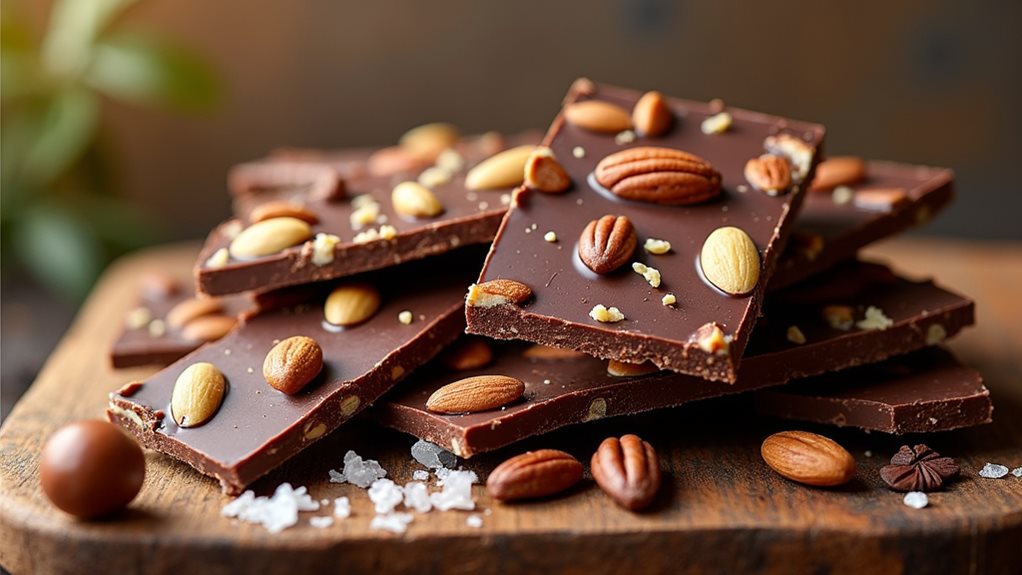
When you pair chocolate with nuts, you'll experience a remarkable contrast between the smooth, melting quality of chocolate and the satisfying crunch of almonds, hazelnuts, or walnuts.
This textural symphony isn't a modern invention but has ancient roots in culinary traditions that recognized how these ingredients complement each other perfectly.
You'll find that toasting nuts before adding them to chocolate intensifies their flavor compounds, creating stronger aromatic notes that enhance the overall compatibility of this classic combination.
Crunch Meets Smooth
The marriage of crunchy nuts and smooth chocolate creates one of the most satisfying sensory experiences in the culinary world.
Through nut variety exploration and texture enhancement techniques, you'll discover how this pairing leverages dynamic sensory contrast to elevate your taste experience.
- Textural Symphony – Combine raw chopped hazelnuts with dark chocolate for maximum crunch against silky smoothness.
- Praline Innovation – Crush pistachios into praline before folding into melted white chocolate for varied texture density.
- Coating Variations – Experiment with different chocolate viscosities when coating macadamia nuts for unique mouthfeel.
- Balance Creation – Layer thinly sliced almonds between chocolate sheets for an architectural approach to texture.
This combination isn't just delicious—it's a calculated balance of complementary elements that engage multiple senses simultaneously.
Ancient Nutty Marriages
Dating back centuries, chocolate and nuts have forged one of culinary history's most enduring partnerships, creating a sensory experience that continues to captivate palates worldwide.
This nutty history showcases how almonds complement milk chocolate with their neutral profile, while hazelnuts enhance dark chocolate's richness. You'll find pecans and dark chocolate creating robust flavor combinations, while macadamias blend perfectly with white chocolate's creamy sweetness.
For your flavor exploration, consider that roasting nuts intensifies their characteristics when paired with chocolate. The contrasting textures—crunchy nuts against smooth chocolate—create a symphony in your mouth that's both satisfying and complex.
Whether in artisanal truffles or simple snacks, these combinations offer nutritional benefits alongside their indulgent nature, proving that some marriages truly are timeless.
Toasting Enhances Compatibility
Through careful toasting, nuts undergo a remarkable transformation that elevates their compatibility with chocolate to new heights. This process doesn't just improve taste—it completely redefines the pairing experience.
When you toast almonds, hazelnuts, walnuts, or cashews, you're revealing depth and complexity that perfectly balances chocolate's richness.
- Toasted nut varieties develop enhanced aroma profiles that complement dark chocolate's intensity.
- The caramelization process creates textural contrast between crunchy nuts and smooth chocolate.
- Flavor profile enhancement occurs as natural oils are released during toasting.
- Roasting reduces moisture content, preventing chocolate from becoming soggy when combined.
You'll find that properly toasted nuts create a more sophisticated mouthfeel and balanced flavor profile.
This technique transforms simple ingredients into gourmet experiences that will impress even the most discerning chocolate enthusiasts.
These nutty additions can elevate traditional chocolate truffles, which have been delighting connoisseurs since their accidental creation by French chef Auguste Escoffier in 1895.
Fruit Pairings That Elevate Chocolate Experiences
Since time immemorial, chocolate has found its perfect companion in nature's sweetest offerings—fruits. The interplay between fruit sweetness and chocolate bitterness creates a sensory experience that transcends ordinary indulgence.
Strawberries complement dark chocolate's intensity, while apples find harmony with milk chocolate's creamy notes.
You'll discover that blueberries' tartness balances beautifully against white chocolate's sweetness, creating a sophisticated flavor profile. For innovative combinations, try raspberries with either white or dark varieties, or explore kiwi with milk chocolate to neutralize acidity.
Beyond taste, these pairings offer nutritional benefits—fruits add fiber and antioxidants while balancing chocolate's caloric density.
Whether celebrating Valentine's Day with classic strawberry-chocolate pairings or experimenting with Asian-inspired yuzu and dark chocolate, fruit transforms chocolate into a multi-dimensional experience.
Beverage Matchmaking With Chocolate Varieties
Every chocolate variety calls for its perfect liquid companion, transforming simple indulgence into a sophisticated tasting experience.
Every masterful chocolate pairing elevates the ordinary into a sensory adventure worth savoring.
When exploring regional varieties, you'll discover that wine, beer, and specialty beverages each bring unique dimensions to chocolate's complex flavor profile.
- Dark chocolate + bold reds – Cabernet Sauvignon and Malbec enhance the rich intensity of high-percentage cacao, creating seasonal pairings that warm winter evenings.
- Milk chocolate + Port wine – The creamy sweetness harmonizes with Port's rich fruitiness for year-round enjoyment.
- Citrus-infused chocolates + Prosecco – The crisp effervescence cuts through chocolate's richness while complementing the citrus notes.
- White chocolate + Japanese green tea – This unexpected pairing balances buttery sweetness with the tea's delicate bitterness, popular in Asian-influenced regional varieties.
For a refreshing alternative, try cranberry orange relish alongside dark chocolate for a flavor melding that combines tartness with rich cocoa notes.
Crafting Your Own Chocolate Pairing Adventures
Armed with knowledge of classic pairings, you're ready to become a chocolate pairing pioneer in your own kitchen. The secret to developing innovative combinations lies in balanced experimentation with both flavors and textures.
Don't hesitate to match dark chocolate with unexpected spices like cayenne or cinnamon, or try milk chocolate with crunchy nuts and creamy cheese for textural contrast.
Your pairing techniques should focus on balancing sweet, sour, salty, and bitter elements while considering texture interactions. Keep notes on successful combinations to refine your flavor exploration journey.
Frequently Asked Questions
Can Chocolate Allergies Affect How We Experience Flavor Pairings?
Yes, your allergy symptoms can directly impact your flavor perception. When you're experiencing discomfort, your taste receptors might respond differently, altering how you'd normally experience innovative flavor combinations with chocolate or its alternatives.
How Do Seasonal Ingredients Impact Chocolate Pairing Recommendations?
Like nature's calendar, seasonal ingredients transform your chocolate pairings. You'll discover richer experiences combining summer's seasonal fruits, winter's holiday spices, spring's local herbs, and fall's festive nuts with chocolate throughout the year.
Are There Cultural Differences in Preferred Chocolate Pairings Globally?
Yes, you'll find rich cultural preferences influencing chocolate pairings worldwide. Global variations emerge through regional ingredients – like Asian matcha, Latin American chilies, and Middle Eastern spices – creating innovative taste experiences across different societies.
Can Chocolate Pairings Enhance Health Benefits of Cacao?
Yes, pairing cacao with foods rich in antioxidants or anti-inflammatory properties can enhance health benefits. When you combine ingredients strategically, you'll amplify cacao compounds' effects on cardiovascular health and cognitive function.
How Do Aged Chocolates Differ in Pairing Potential?
You'll find aged chocolates offer superior pairing versatility due to their flavor complexity. The age development intensifies notes and creates nuanced profiles that'll reveal more adventurous combinations with spirits, cheeses, and unexpected ingredients.
Final Thoughts
As you explore chocolate pairings, you'll discover that conventional wisdom about matching similar flavor intensities holds true scientifically. Researchers have found that compounds in chocolate create unique reactions with complementary ingredients, enhancing both profiles. Whether you're balancing dark chocolate's bitterness with citrus, adding nuts to milk chocolate for textural contrast, or brightening white chocolate with berries, trust your palate's response. Your perfect pairing adventure is ultimately guided by your personal taste preferences.

